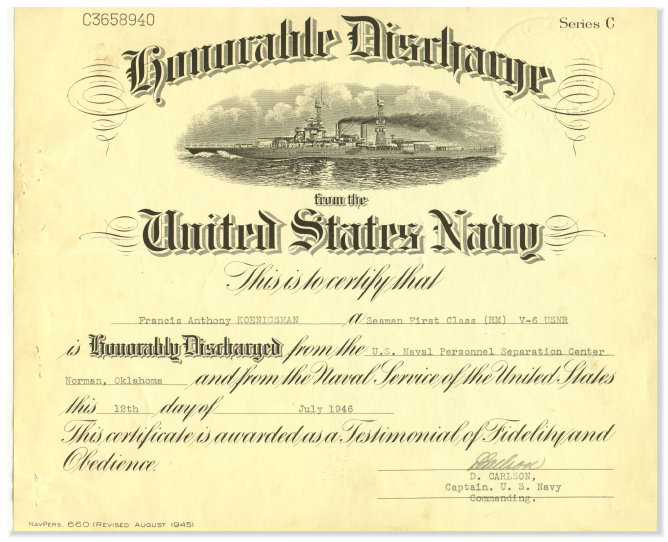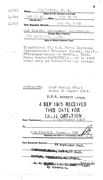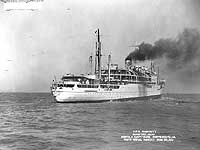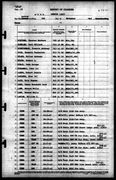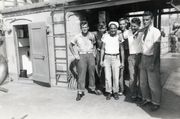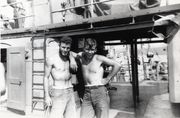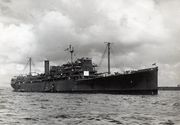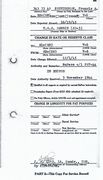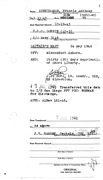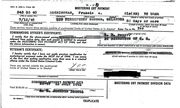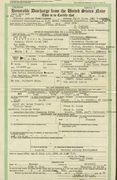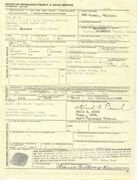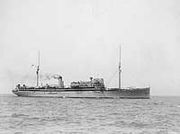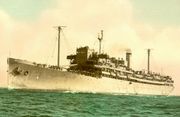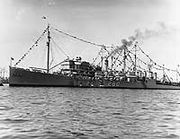|
Transfer to
TADCEN
|
Transfer to
COMPHILSEAFRON
|
|
Transfer to
U.S.S. Dobbin
|
U.S.S. Dobbin
Muster
Roll -
Report of Changes
|
Frank’s next transfer occurred on Tuesday, August 14, 1945 when he was officially transferred to the Naval Training & Distribution
Center (TADCEN), Shoemaker, Alameda County, California for "assignment to duty by Code 80 ComWesSeaFron" (Commander, Western Sea Frontier).
The transfer noted that "This man is a graduate of NavTraCen., (RM) Gulfport, Miss., and by direction of the Chief of Naval Personnel
must be assigned to duty where his specialized training may be fully utilized." Prior to arriving in California, Frank was awarded
5 days "Delay Leave" from 19-Aug-1945 to 24-Aug-1945. Frank was officially Received Aboard at TADCEN, Shoemaker, California
on August 24, 1945.
Then again on Saturday, September 1, 1945, Frank was transferred via U.S. Naval Barracks (Embarkation) Treasure
Island, California to Receiving station, Samar Philippine Islands, for further assignment to the Commander, Service Forces, 7th Fleet.
The official orders used the military abbreviation terminology "Recsta., ULOD, Furas ComServSEVENTHFlt." [Translation: "Recsta"
= Receiving Station; "ULOD" = shipping destination code for Samar Philippine Islands; "Furas" = For Further Assignment; "ComServSEVENTHFlt"
= Commander, Service Forces, 7th Fleet.].
Frank borded the Troop Transport ship U.S.S. Barnett (APA-5) for transport to the Philippines.
According to the Dictionary of Naval Fighting Ships, "On 4 September, Barnett embarked occupation troops and set sail for the Philippines.
Arriving at Samar on the 26th...". He was officially received aboard COMPHILSEAFRON (Commander, Philippine Sea Frontier) on
Saturday, September 29, 1945 and then on Tuesday, October 16th was assigned to the U.S.S. Dobbin and transported via the Naval Air
Transport Service from Samar to Sancley.
 |
Frank Koenigsman, S1C(RM)
WWII Navy Service Summary
|
 |
(Continued)
Frank finally reported aboard the Destroyer Tender U.S.S. Dobbin (AD-3) on October 19, 1945, a Friday, while she was in Subic Bay,
Philippine Islands (P.I.). Subic Bay is a bay of Luzon Island and is part of the Zambales Province. Just two weeks laterDobbin left Subic Bay around November 2, 1945 and transferred to Leyte Gulf, P.I. (Leyte Gulf forms the eastern edge of Leyte Island
and the southern end of Samar Island) before leaving the Philippines around November 13th and returning to San Diego, California on
Friday, December 7, 1945. While on the return voyage to the states, Frank was promoted to Seaman First Class, Radio Man (S1C(RM))
on December 1, 1945.
Destroyer Tenders, such as the Dobbin, are auxiliary support ships that service and supply destroyers.
Frank said that the Dobbin carried a machine shop with tools and equipment capable of manufacturing any part needed
on a destroyer.
|
"Part of the gang.
This was taken on the
bridge of the ship (Dobbin)"
|
"The Hot days on Subic Bay"
|
"Picture
of the Dobbin.
This was taken in Samar Phillipines I. the day before we left for the states.
Note the movie screens." |
Promotion to S1C(RM)
|
After returning to the states, Frank remained stationed aboard the Dobbin for another seven months while she was docked in San Diego.
While stationed in San Diego, he must have had a little too much free time on his hands because on May 24, 1946 Frank was charged
with the offense "Misconduct Ashore" and awarded "Thirty (30) days deprivation of Shore Liberty".
For his Naval service, Frank
was awarded the Asiatic Pacific Ribbon, American Area Ribbon and World War II Victory Ribbon.
|
Transfer for Discharge
|
Awards
|
Summary of Service
|
|
Mustering Out Payment
|
Honorable Discharge
Form
|
Notice
of Separation
|
On July 7, 1946, Frank was transferred to I/S San Diego for further transportation to the Personnel Separation Center (PSC), Norman,
Cleveland County, Oklahoma for discharge. Frank was officially Honorably Discharged on Friday, July 12, 1946, having served
1 year, 7 months and 9 days.
|
Asiatic-Pacific
Ribbon
|
Awarded to any member of the United States military who served in the Pacific
Theater from 1941 to 1945. (Wikipedia)
The suspension ribbon and ribbon bar are yellow with 3 vertical stripes, blue, white and
red - the colors of the U.S. - in the center. Three more vertical stripes, white, red, and white - representing the colors of Japan
- appear near each edge. (Air Force Combat Medals, Streamers, and Campaigns, p58. (PDF file))
See additional information and
description at FoxFall Medals
|
|
American Area
Ribbon
|
Awarded for either one year of consecutive duty within the continental borders
of the United States, or 30 days consecutive/60 non-consecutive days of duty outside the borders of the United States but within the
American Theater of Operations, between December 7, 1941 to March 2, 1946. (Wikipedia)
The suspension ribbon and ribbon bar are
bright azure with the colors of the United States - blue, white and red - running in a vertical stripe down the center. A white and
a black stripe, representing the colors of Germany, appear vertically near each edge, with the colors of Japan, a red and a white
strie, next to and inside the German colors. (Air Force Combat Medals, Streamers, and Campaigns, p50. (PDF file))
See additional
information and description at FoxFall Medals
|
|
WWII Victory
Ribbon
|
Awarded to any member of the United States military, including
members of the armed forces of the Government of the Philippine Islands, who served on active duty, or as a reservist, between December
7, 1941 and December 31, 1946.
The edges of the ribbon revisit the multi-colored rainbow ribbon of the Allied World War I Victory
Medal. This again honors all the allied nations. The wide red center represents the new sacrifice of blood by World War II combatants.
The thin white lines separating the central red band from the outer multi-colored bands represent the rays of new hope, two of them
signifying that this was the second global conflict. (Wikipedia)
See additional information and description at FoxFall Medals
|
|
Underway during the
U.S. Fleet review
4 June 1927
|
|
Moored in San Diego harbor, CA
Along
with 4 destoyers
Navy Day, 27 October 1932
|
|
Destroyer Tender U.S.S. Dobbin (AD-3), named for James Cochrane Dobbin, was launched 5 May
1921 by Philadelphia Navy Yard and commissioned 23 July 1924. She served in both the Atlantic and Pacific oceans between her launch
and the beginning of WWII.
Dobbin was moored at Pearl Harbor on December 7, 1941 during the Japanese surprise attack, but received
only minor damage, although three sailors were killed during the attack. (Action Report) She served the remainder of the war in the
Pacific (bases in Hawaii, Australia, New Guinea and the Philippines), returning to San Diego 7 December 1945. Dobbin received one
battle star for World War II service and was decommissioned 27 September 1946. (Dictionary of American Naval Fighting Ships)
| ||
